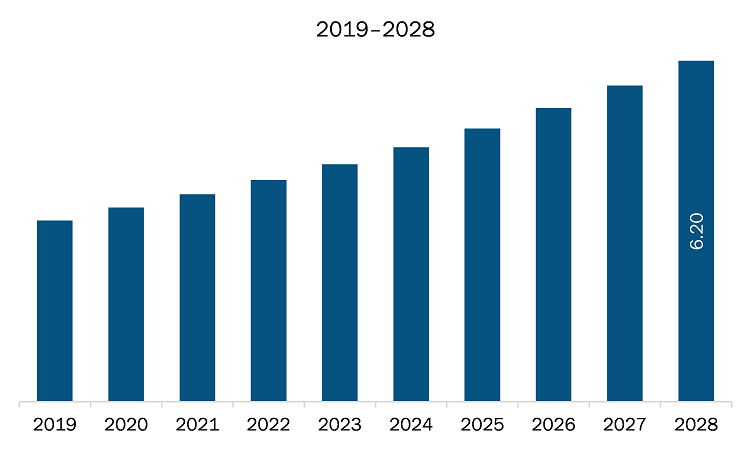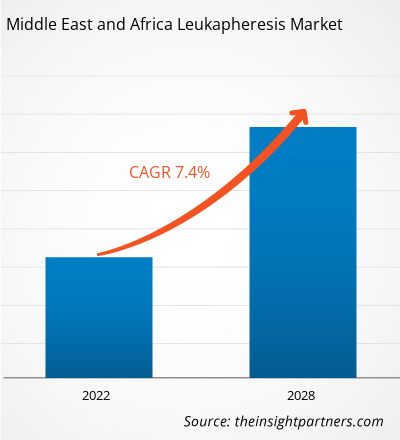The leukapheresis market in Middle East & Africa is expected to grow from US$ 3.77 million in 2021 to US$ 6.20 million by 2028; it is estimated to grow at a CAGR of 7.4% from 2021 to 2028.
Blood transfusion is an integral part of the national health infrastructure and policies of various countries. Advancements in the medical industry have led to improvements in the treatment procedures of serious illnesses and injuries, which eventually has propelled the need for blood transfusion for patients’ survival. Growing awareness regarding the importance of blood transfusion and blood availability in healthcare services has led to rise in the number of people willing to donate their blood for medical causes. As per the World Health Organization (WHO) data, ~117.4 million blood donations were reported worldwide in 2018. Blood donors are usually classified to be voluntary unpaid, paid, and family/replacement, and as per the WHO claims, voluntary/unpaid donors are the major source of a reliable and adequate supply of blood. According to WHO data in 2019, blood donations by voluntary unpaid donors increased by 11.6 million from 2008 to 2015 in 139 countries in the world. The trend of blood donation is also gaining significant prominence in low and middle-income countries. According to the data presented during the CAG annual meeting 2017, ~13,000 procedures were performed on 1,087 patients in 2016. National programs developed and rolled out in many countries are further attracting a large number of platelet and blood donors. Thus, the rising number of eligible donors in different countries across the world is fostering the need for leukapheresis equipment that is used to separate the required blood components.Middle East & Africa have been witnessing a growing number of COVID-19 cases since its outbreak. Economic uncertainties and ongoing conflicts are worsening the condition in the region. For instance, countries such as Syria, Libya, and Yemen are suffering violent conflict and cannot implement any public health measures. Iran was in deep economic recession due to the US sanctions. Also, the major source of economic stabilization in Middle East countries is oil production and export. However, the recent pandemic is causing turbulence to the economies of the Middle East region. Further, the adoption of plasma therapy for covid patients is impacting the market in the positive way. UAE is turning to a century-old treatment for viral disease that is showing promise with patients. Known as Convalescent Plasma therapy, it involves taking virus-killing antibodies from the blood of people who have recovered from the disease and donating them to the critically ill. With anti-virals still undergoing human trials and a vaccine at least a year away, CP therapy is being seen as a vital stopgap measure against the pandemic in the region. On April 12, 2020, medics at Sheikh Khalifa Medical City in Abu Dhabi announced that they were treating a patient with the plasma of an Emirati who had recovered from the virus.
With the new features and technologies, vendors can attract new customers and expand their footprints in emerging markets. This factor is likely to drive the Middle East & Africa leukapheresis market. The Middle East & Africa leukapheresis market is expected to grow at a good CAGR during the forecast period.
- This FREE sample will include data analysis, ranging from market trends to estimates and forecasts.
Middle East & Africa Leukapheresis Market Segmentation
Middle East & Africa Leukapheresis Market – By Product Type
- Leukapheresis Disposables
- Leukapheresis Devices
Middle East & Africa Leukapheresis Market – By Application
- Research Applications
- Therapeutic Applications
Middle East & Africa Leukapheresis Market – By Product Type
- Blood Component Providers and Blood Centers
- Hospitals and Transfusion Centers
- Pharmaceutical and Biotechnology Companies
- Academic and Research Institutes
Middle East & Africa Leukapheresis Market – By Country
- Saudi Arabia
- UAE
- South Africa
- Rest of Middle East & Africa
Middle East & Africa Leukapheresis Market – Companies Mentioned
- Asahi Kasei Corporation
- Fresenius SE & Co. KGaA
- Haemonetics Corporation
- Terumo Corporation
- STEMCELL Technologies Inc.
- HemaCare
- Macopharma
- AllCells
- BioIVT
Middle East and Africa Leukapheresis Report Scope
| Report Attribute | Details |
|---|---|
| Market size in 2021 | US$ 3.77 Million |
| Market Size by 2028 | US$ 6.20 Million |
| Global CAGR (2021 - 2028) | 7.4% |
| Historical Data | 2019-2020 |
| Forecast period | 2022-2028 |
| Segments Covered |
By Product Type
|
| Regions and Countries Covered | Middle East and Africa
|
| Market leaders and key company profiles |
- Historical Analysis (2 Years), Base Year, Forecast (7 Years) with CAGR
- PEST and SWOT Analysis
- Market Size Value / Volume - Global, Regional, Country
- Industry and Competitive Landscape
- Excel Dataset


- Machine Condition Monitoring Market
- Carbon Fiber Market
- Helicopters Market
- Identity Verification Market
- Investor ESG Software Market
- Parking Management Market
- Embolization Devices Market
- Passport Reader Market
- Medical Audiometer Devices Market
- Quantitative Structure-Activity Relationship (QSAR) Market

Report Coverage
Revenue forecast, Company Analysis, Industry landscape, Growth factors, and Trends

Segment Covered
This text is related
to segments covered.

Regional Scope
North America, Europe, Asia Pacific, Middle East & Africa, South & Central America

Country Scope
This text is related
to country scope.
Trends and growth analysis reports related to Life Sciences : READ MORE..
- Asahi Kasei Corporation
- Fresenius SE & Co. KGaA
- Haemonetics Corporation
- Terumo Corporation
- STEMCELL Technologies Inc.
- HemaCare
- Macopharma
- AllCells
- BioIVT

 Get Free Sample For
Get Free Sample For